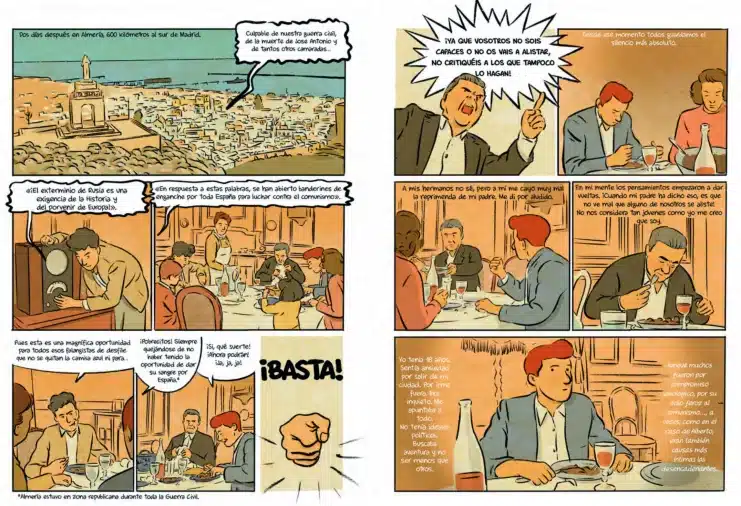
Blue hell. Volume 1, by Paco Asenjo, is a comic based on a true story, initially published thanks to crowdfunding, but now published by cARTEm Comics, who will be responsible for publishing the second volume in the graphic novel collection.
The Blue Hell’s Comedy. Volume 1, published by cARTEm Cómics for a wider audience than crowdfunding, is a work with Paco Asenjo as the main writer, recounting the adventures of Alberto, a young man who enlists to fight against Russia in World War II. Battle in the Spanish Legion in the Blue Room.
The battles fought by these Spanish soldiers collected in the ninth art can be read in addition to the current Blue Inferno in 1941 Volkhov, Daniel Ortega and Antonio Gil and Hasta Novgorod. Class Chronicles by Victor Barba. His idiosyncratic character was seen in a brutal but realistic war scene in the movie Espanci.
“What was the snow like in Russia? The snow in Russia was red and black
Alberto, the protagonist of Paco Asenjo’s Blue Inferno
Spanish soldiers of World War II
In the year The end of the Spanish Civil War in 1939 was not the end of ideologies, so the fighters rejoined other wars and groups, trying to win their ideals. This interwar ideological struggle was fought in many countries and grew strongly, with echoes of the Cold War continuing, as CARTEm previously published in The Cambridge Five, a masterpiece about British Soviet spies in Great Britain.

The rebel army’s victory over the republican government led to the 1941 war between the two factions in Transfraternity. Indeed, on the Russian front, the Spaniards fought on behalf of the Germans in the Blue Division; Also in favor of the Soviets, as soldiers and airmen in the Red Army, including women, – in the fictional British Johnny Red – and something reflected in the partisans.
The fighting of the Spanish veterans of the Civil War also took place in the French resistance – CARTEm published the Sniper Elite in reference to this French group – or in the 2nd armored division of the Free France, the famous Leclerc division, more than 2,000 Spanish republicans who fought on the African and later European stage. 9 of this division, the Ninth Company, composed mainly of Spanish anarchists, was the first group to march into Paris for independence.
Finally, both volunteered, drowned in oblivion, because for the Franco regime, Hitler, was the link of communication with the loser of the competition and it closed him to recognize the winners; The soldiers who sacrificed themselves for the alliance were so confused that they quickly spread a curtain of silence and sealed their graves.
The plot of the Blue Hell
Paco Asenjo told his story in 2011. It begins in 2001, the protagonist Alberto, already in his seventies, is interviewed as the only survivor of the Roman battalion Esparza’s regiment. In this interview, he recalls his volunteering to fight in Russia, his adventures in training, the trip to Poland and his first battles until he reached the Volkhov River.
Alberto was not a soldier, nor a political idealist, nor a defender of any ideology, but at the age of nineteen and with the impulse of youth he intended to live an adventure, for the German Blitzkrieg was like many of the 1930s. In the summer of 1941, before the Spanish divisions could get there, the USSR would be defeated.
The volunteers of the blue class were the veteran soldiers – from labor and specialist soldiers to the Falang, members of the latter, anti-communists, who wanted to ingratiate themselves with the victors, they were or were. A family member, on the Republican side; People who want to get out of misery – like German soldiers and legionaries are paid – and like the main character Alberto, they are seduced by propaganda and adventure.


In Infierno Azul, Alberto says goodbye to Spain on the train to Europe, trains at Grafenwohr in Germany, and says he will leave wearing his German uniform. Then they head to Smolensk from the Polish border with the USSR, they are ordered to go to Vitebsk and finally they reach Novgorod near Leningrad.
On the Russian front, the Germans initially intended to camp the Spanish volunteers near Moscow, but as reported by the Blue Inferno, the resistance of the Soviets caused the German General Staff to turn them north, but the Spaniards did not carry any clothing or clothing. An ideal weapon for a front where autumn temperatures can drop to 50ºC below zero as suffered by Napoleon and his soldiers in the memory of the Napoleonic army.
The Spanish soldiers were considered by the Germans to be very noisy and pathetic at first, but after the baptism of fire and the following battles, they gained German admiration. At the same time, in the plot of Infierno Azul, it was observed how the Spaniards followed a more compassionate respect for the people and protected them from German cruelty.
Biography
Alberto’s story in Infierno Azul is not a simple war story created by Paco Asenjo, but a true life story. In this first volume, the screenwriter shows how a young man changes, thanks to the experience he has gained in his life, there are bad times with other very good ones. From being a caretaker in the family nest, to being a busy startup and, later, a cuddle buddy. In short, according to Ortega-Gasset, the human being with the situation.


Alberto himself warns, “Today, at 78 years old, it is very difficult to explain something I did when I was 19,” so the character’s evolution is evident on the first page of the volume. ”, completing a common sentence of a man who has seen a lot in his life, “When a grown man says he wants war, he’s not right in the head.
The plot of Infierno Azul is by no means brutal or uninteresting, as the sequence followed by Paco Asenjo’s memories of Alberto is presented in sequence and alternating scenes, at the same time providing content for the background of the story and showing the development. The main character and his companions.
At the same time, the author makes a more schematic drawing with clean lines used in Infierno Azul to facilitate the plot, as well as the use of flat colors that facilitate the transition between day and night scenes. A simple contrast that occurs on a battlefield at night when bullets are fired from the barrels of weapons and explosions are fired over fields or buildings.
In short, this first volume of Infierno Azul by Paco Asenjo’s great artwork immerses the reader in an adventure beyond the war story, as it shows the evolution of the protagonist Alberto’s humanity. Contradictions in war and how to deal with them. Blue hell. Volume 1 is published on cardboard by cARTEm Comics, has 208 pages and measures 17 x 24 cm.


A war comedy based on true events
Alberto, a 19-year-old boy with no combat experience or political leanings, decides to join the Blue Unit, wanting to live what seems like a great adventure. Believing himself to be part of a quick German victory over the Soviet Union, he suddenly faced the grim reality of a protracted and brutal conflict in the middle of the worst winter of the 20th century.
His story is inspired by the true experiences of Alberto, a member of the famous Roman battalion of the II Battalion of Esperza’s regiment. As the war progresses, Albert becomes an important figure, serving as a trusted liaison to the commander and a key witness in the many battles fought on the Volkov front.